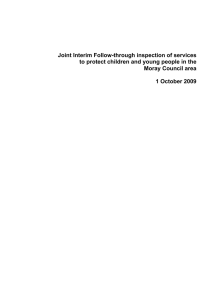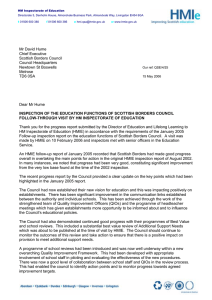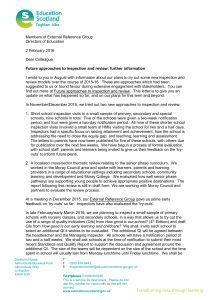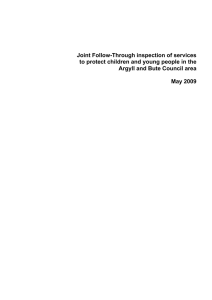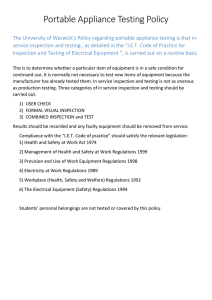Joint Follow-Through inspection of services Moray Council area
advertisement
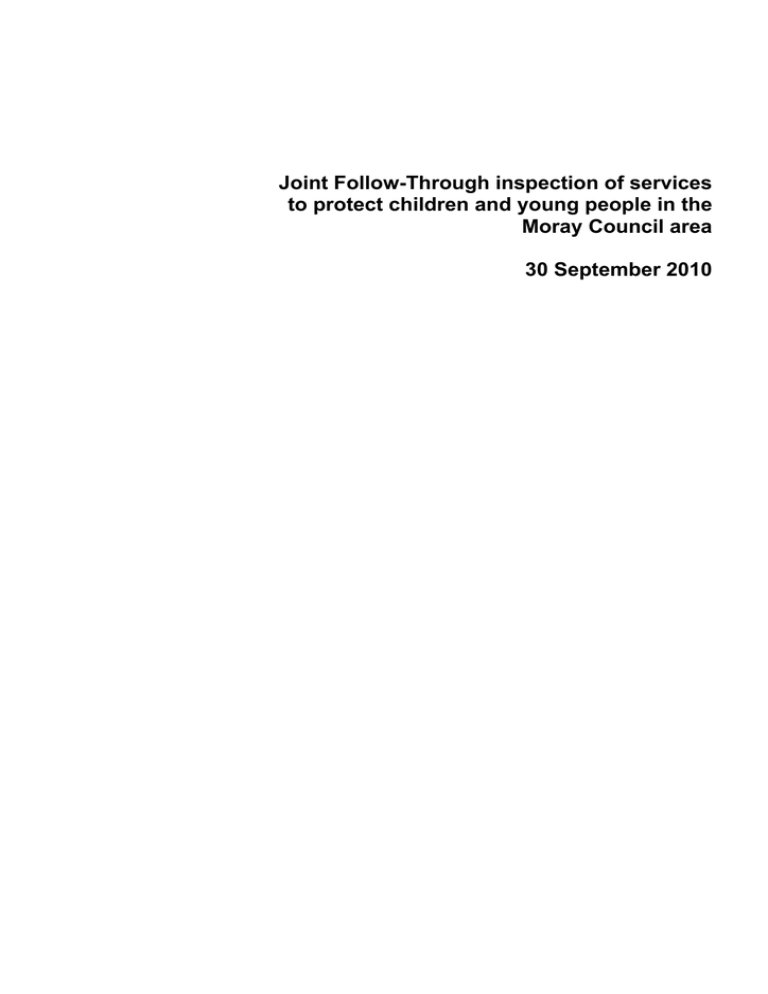
Joint Follow-Through inspection of services to protect children and young people in the Moray Council area 30 September 2010 Contents Page Introduction 1 1. The inspection 2 2. Continuous improvement 2 3. Progress towards meeting the main points for action 2 4. Conclusion 6 How can you contact us? 8 Introduction The Joint Inspection of Children’s Services and Inspection of Social Work Services (Scotland) Act 2006, together with the associated regulations and Code of Practice, provide the legislative framework for the conduct of joint inspections of the provision of services to children. Inspections are conducted within a published framework of quality indicators, How well are children and young people protected and their needs met?. 1 Inspection teams include Associate Assessors who are members of staff from services and agencies providing services to children and young people in other Scottish local authority areas. 1 How well are children and young people protected and their needs met?. Self-evaluation using quality indicators, HM Inspectorate of Education 2005. 1 1. The inspection HM Inspectorate of Education (HMIE) published a report on the joint inspection of services to protect children and young people in the Moray Council area in February 2009. Working together, services within the Moray Council area prepared an action plan indicating how they would address the main points for action identified in the original HMIE inspection report. Inspectors revisited the Moray Council area, at the request of Scottish Ministers, in June 2009 to assess early progress in responding to the main points for action. A joint interim follow-through inspection report of services to protect children and young people was published in October 2009. In June 2010, inspectors returned to the Moray Council area to carry out an evaluation of progress in responding to the main points for action from in the original inspection report in February 2009. 2. Continuous improvement The North East of Scotland Chief Officers Group has now taken collective responsibility for public protection and is developing ways of gathering information on how well services are performing. Following a review of the North East of Scotland Child Protection Committee (NESCPC), a Moray Child Protection Sub Committee (MCPSC) has recently been established to increase responsibility for protecting children in the local authority area. Effective communication between the NESCPC, MCPSC and front line staff required to be developed more fully. A Performance and Improvement Officer had very recently been appointed to support the work of the MCPSC. The Police Divisional Commander for the area is now leading the Moray Alcohol and Drug Partnership (MADP). Plans have been developed to meet the needs of children affected by parental alcohol abuse through more effective early identification and intervention. 3. Progress towards meeting the main points for action The initial inspection report published in February 2009 identified six main points for action. 3.1 Ensure that assessments of risk are rigorous and appropriate legal measures are used, when necessary, for children in need of protection Good progress had been made in ensuring initial assessments of risk were rigorous and appropriate legal measures were used, when necessary, for children in need of protection. 2 Inter-agency guidance and procedures for assessing risks had been strengthened and made more accessible to staff. Across services, there had been significant improvements in information-sharing at an early stage, particularly by health staff. This had led to more effective initial assessments of risks to children. Inter-agency training had helped clarify roles and responsibilities of staff. As a result, they were more confident about sharing child protection concerns without delay. However, some staff in schools were still uncertain about the new procedures they needed to follow to report their concerns. When children were identified as at immediate risk of harm, appropriate steps were taken to keep them safe. In an emergency, when it was no longer safe for children to remain at home, there was a more robust approach by social work staff to carrying out checks on the suitability of relatives and friends before deciding to place children in their care. Council solicitors and social work staff were now working well together to use emergency legal measures to protect children. If agreement on using these could not be reached, and social workers still had concerns, there were procedures in place to resolve this. Social workers had a clearer understanding of the action they needed to take and were more confident in doing so. Compulsory measures of supervision were now being used more appropriately and effectively to keep children safe. 3.2 Fully implement agreements and guidance to ensure the effective sharing of information Both within and across services good progress had been made in implementing agreements and guidance to ensure information was shared more effectively. Police concerns about children’s safety and well-being were now more systematically communicated to staff in health, social work and education. As a result, they were in a better position to respond appropriately. Information-sharing about those sex offenders who may pose a risk to children had been strengthened through Multi-Agency Public Protection Arrangements (MAPPA). Health staff were more fully involved in these arrangements. Health visitors and school nurses were now working together in teams, enabling them to become more involved in the gathering and sharing of relevant information. The specialist nurse for child protection and the children and families hospital social worker in Dr Gray’s Hospital were having a beneficial impact on practice. It was recognised that further work was required to enhance inter-agency information-sharing by staff in the Accident and Emergency Department. Paediatricians at Dr Grays Hospital and the Royal Aberdeen Children’s Hospital (RACH) were working more closely together to respond to the needs of very young children with non-accidental injuries. Communication about the discharge of vulnerable newborn babies between Aberdeen Maternity Hospital and community midwives and health visitors in Moray was variable. Good practice in information sharing was helpfully included in staff training on Local Integrated Assessment and Planning (LIAP) arrangements and Initial 3 Referral Discussions (IRDs). Education staff were not always holding LIAP meetings as soon as concerns about a child were identified. This diminished the effectiveness of information-sharing to ensure children got the help they needed at an early stage. Staff were now seeking and sharing information in a more systematic way. Clear arrangements for staff to seek the consent of children and parents to share their personal information were now in place. There were encouraging examples of these being used well by some staff, but they were not yet applied consistently. The quality and availability of dated records of significant events in a child’s life to inform risk assessment was variable. 3.3 Introduce inter-agency discussions to manage effectively the investigation of suspected child abuse Satisfactory progress had been made in introducing inter-agency discussions to effectively manage the investigation of suspected child abuse. IRDs had very recently been implemented. These helpfully involved staff from health and education services as well as police and social workers. Staff were becoming more confident about participating in IRDs. However, they were not always clear about their respective roles and responsibilities. A consultant paediatrician was always available and now provided a medical opinion at an early stage in response to child protection concerns. Improved arrangements were working well to transfer children to RACH for more specialist child protection medical examinations. Paediatricians at Dr Gray’s Hospital did not always receive feedback about children referred to RACH for child sexual abuse medical examinations. As a result, they were not always in a position to ensure that these children’s health needs were followed up. Staff in the co-located police and social work unit had greatly improved the planning of more complex investigations. 3.4 Improve assessment, planning and decision-making for children whose names are on the Child Protection Register (CPR) Good progress had been made in improving assessment, planning and decision-making for children whose names were on the Child Protection Register (CPR). Staff had benefited from multi-agency training on new guidance and procedures for risk assessment. A standardised format for assessing risks and needs was helping social workers to improve their practice. Plans were being taken forward to improve risk assessment, planning and recording practices by health visitors and school nurses. Enhanced supervision of public health practitioners was being introduced to support this. Procedures had been developed to implement a shared assessment process across services. Staff acknowledged that there was still much to be done to fully establish such an approach in practice. Improved risk assessments were resulting in better quality reports to case conferences and the Children’s Reporter. These now included clearer recommendations and options for decision-making. They were beginning to have 4 a sharper focus on children’s needs and what was required to protect and support them. More account was being taken of the views of children and families in decision-making about their lives. There was now a clear structure and agenda to conduct the business of case conferences. The enhanced role of the chairperson was ensuring greater consistency in decision-making. There were improvements in attendance and contributions from staff. The involvement of children and families had been further strengthened. The role of core group meetings was clearer and they were now more effective. Overall, the attendance of key people and the frequency of meetings were much improved. The business of meetings was now clearly fixed on monitoring progress with the child’s protection plan and, where necessary, amending it to meet changing circumstances. Managers recognised the need for greater consistency of practice in assessing risks and needs both within and across services. Measurements had been introduced by social work to demonstrate that improvements in processes resulted in improved outcomes for children and families. Managers should ensure that this approach continued to be informed by sound professional practice and judgement. 3.5 Increase the involvement of children in decision-making about their lives and consult them on the development of services to protect children Overall, good progress had been made towards meeting this point for action. Significant progress had been made in involving children in decision-making about their lives. More work needed to be done to consult them on the development of services. The views of children and parents were now sought more routinely. Improvements in assessment processes ensured that a stronger emphasis was placed on seeking children’s views. Strenuous efforts were made to ensure that these views were reported accurately through, for example, direct quotes rather than a worker’s interpretation of views. The views of children and parents were now an important consideration in planning and decision-making. Parents and children were taking a more active part in assessments and devising plans and staff were working hard to ensure that they fully understood them. There were encouraging signs that parents and children were beginning to take some responsibility for meeting some of actions set out in plans. The preparation for carrying out joint interviews and medical examinations routinely took account of the views and needs of the child. Staff were supporting young people to take part appropriately in child protection case conferences. Some young people were now attending core group meetings. Health and social work reports were now more routinely shared with parents and children in advance of child protection case conferences. The recent increase in advocacy services was helping children to participate more fully in a range of meetings. More needs to be done to promote this service to all children who could 5 benefit from it. Having Your Say forms were now more widely used to help children express their views in preparation for meetings making decisions about their lives. There was an increasing focus on seeking feedback from users of services to protect children on their experiences and the quality of service they had received. There were some very effective examples of the views of children and parents being used to improve practice. There were encouraging examples of staff getting feedback from children and families as new ways of working were introduced. However, these efforts to involve children and families in the development of services were not systematic or coordinated well. Staff were not always aware of the work being carried out outside their own service. 3.6 Improve the effectiveness of the NHS Protecting Children Group, the NESCPC and the MCOG in protecting children and meeting their needs Progress in improving the effectiveness of the key strategic groups providing leadership and direction in protecting children and meeting their needs was satisfactory. NHS Grampian had published a child protection strategy which gave a higher priority to this area of work. The Protecting Children (Health) Group had successfully raised the profile of child protection with staff who worked directly with children and with adults who cared for children. Paediatric services to protect children at Dr Gray’s Hospital were supported and monitored better. The NESCPC was fulfilling its remit more effectively. It had produced a framework to assist staff in assessing risks to children. Guidance had been developed to support staff when working with uncooperative families, and children and young people involved in under-age sexual activity. It was successfully raising staff awareness of the impact of parental mental ill-health on children. Staff had recently benefited from seminars coordinated by the NESCPC to share the learning from significant case reviews. Work had started on collecting information from which to measure improvements in service quality over time. The Moray Chief Officers Group (MCOG) had agreed shared priorities for improvement Structures to deliver child protection had been revised to provide increased opportunities for more effective partnership working. 4. Conclusion Overall, good progress had been made in responding to the main points for action in the original inspection report in February 2009. Services, individually and collectively, had taken forward improvements in important areas, including the use of appropriate legal measures; information-sharing between paediatricians; social work and police; risk assessment and planning at child protection meetings; and the involvement of individual children in decision-making. Members of the MCPSC were confident they could provide stronger collective leadership and direction to build on the progress already made. Approaches to delivering service improvements through self-evaluation were at an early stage of development in 6 individual services. Leadership of a coordinated approach to joint self-evaluation was needed to ensure that changes to key processes have a positive impact on children in need of protection. During 2011 – 2012, inspectors will revisit the council area to conduct a joint inspection of services to protect children as part of the second cycle of child protection inspections across Scotland. Emma McWilliam Inspector September 2010 7 How can you contact us? If you would like an additional copy of this report Copies of this report have been sent to the Chief Executives of the local authority and Health Board, Chief Constable, Authority and Principal Reporter, Members of the Scottish Parliament, and other relevant individuals and agencies. Subject to availability, further copies may be obtained free of charge from HM Inspectorate of Education, First Floor, Denholm House, Almondvale Business Park, Almondvale Way, Livingston EH54 6GA or by telephoning 01506 600262. Copies are also available on our website www.hmie.gov.uk. If you wish to comment about this inspection Should you wish to comment on any aspect of this inspection you should write in the first instance to Neil McKechnie, HM Chief Inspector at HM Inspectorate of Education, Denholm House, Almondvale Business Park, Almondvale Way, Livingston EH54 6GA. Our complaints procedure If you have a concern about this report, you should write in the first instance to our Complaints Manager, HMIE Business Management Unit, Second Floor, Denholm House, Almondvale Business Park, Almondvale Way, Livingston EH54 6GA. You can also e-mail HMIEcomplaints@hmie.gsi.gov.uk. A copy of our complaints procedure is available from this office, by telephoning 01506 600200 or from our website at www.hmie.gov.uk. If you are not satisfied with the action we have taken at the end of our complaints procedure, you can raise your complaint with the Scottish Public Service Ombudsman. The SPSO is fully independent and has powers to investigate complaints about Government departments and agencies. You should write to the SPSO, Freepost EH641, Edinburgh EH3 0BR. You can also telephone 0800 377 7330 (fax 0800 377 7331) or e-mail enquiries to ask@spso.org.uk. More information about the Ombudsman’s office can be obtained from the website: www.spso.org.uk. Crown Copyright 2010 HM Inspectorate of Education This report may be reproduced in whole or in part, except for commercial purposes or in connection with a prospectus or advertisement, provided that the source and date thereof are stated. 8
